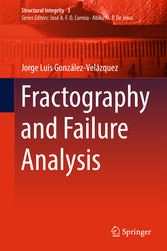Suche
Lesesoftware
Info / Kontakt
Fractography and Failure Analysis
von: Jorge Luis González-Velázquez
Springer-Verlag, 2018
ISBN: 9783319766515 , 172 Seiten
Format: PDF, Online Lesen
Kopierschutz: Wasserzeichen




Preis: 139,09 EUR
eBook anfordern 
Preface
6
Contents
9
1 The Fractographic Examination
12
Abstract
12
1.1 Introduction
12
1.2 Methodology of the Fractographic Examination
15
1.3 Cleaning and Care of Fractures
18
1.3.1 Fracture Handling
18
1.3.2 Cutting of Fractured Pieces
19
1.3.3 Fracture Cleaning
21
1.3.4 Preservation of Fractures
23
1.4 Photographing Fractures
23
1.5 Replicas
28
2 Elements of Fractography
32
Abstract
32
2.1 Classification of Fractures
32
2.2 Mechanical Aspects of Fracture
35
2.3 General Fracture Model
38
2.4 Fracture Lines
40
2.4.1 Types of Fracture Line
40
2.4.2 Chevrons
40
2.4.3 Beach Marks
43
2.4.4 Ratchet Marks and Ridges
45
2.4.5 Shear Lips
46
2.5 Macroscopic Cleavage
48
2.6 Multiple Cracking
50
2.7 Microscopic Fractography
52
2.8 Fracture Micromechanisms
54
3 Brittle and Ductile Fractures
59
Abstract
59
3.1 Brittle Fracture
59
3.1.1 Cleavage
59
3.1.2 Quasi-Cleavage
65
3.1.3 Pseudo-Cleavage
67
3.1.4 Cleavage in Amorphous Materials
67
3.1.5 Intergranular Brittle Fractures
68
3.2 Ductile Fractures
70
3.2.1 Macroscopic Appearance of Ductile Fractures
70
3.2.2 Ductile Fracture Mechanism
73
3.2.3 Void Nucleation and Growth Mechanisms
76
3.2.4 Ductile-Brittle Transition
77
3.2.5 Ductile-Brittle Combined Fractures
79
4 Fatigue Fracture
80
Abstract
80
4.1 General Aspects of Fatigue
80
4.2 Fractography of Stage I Fatigue
87
4.2.1 Macroscopic Characteristics of Stage I Fatigue
87
4.2.2 Microscopic Characteristics of Stage I Fatigue
88
4.2.3 Fatigue Crack Nucleation Mechanisms
88
4.3 Fractography of Stage II Fatigue
93
4.3.1 Macroscopic Characteristics of Stage II Fatigue
93
4.3.2 Microscopic Characteristics of Stage II Fatigue
95
4.3.3 Striation Formation Mechanisms
99
4.3.4 Fractographic Characteristics of Stage II Fatigue Fracture in the Absence of Striations
101
4.4 Corrosion-Fatigue
102
5 Environmentally-Assisted Fracture
105
Abstract
105
5.1 General Aspects of Environmentally-Assisted Fracture
105
5.2 Fundamentals of Metal Corrosion
108
5.3 Stress Corrosion Cracking
112
5.3.1 Mechanical Aspects of Stress Corrosion Cracking
112
5.3.2 Characteristics of SCC Fractures
114
5.3.3 SCC Mechanisms
118
5.4 Creep Fracture
119
5.4.1 General Aspects of Creep Fracture
119
5.4.2 Creep Fracture Mechanism
121
5.4.3 Creep Crack Growth
123
5.5 Hydrogen-Induced Cracking
125
5.5.1 Hydrogen-Induced Cracking Mechanism
125
5.5.2 Fractography of Hydrogen-Induced Cracking
126
5.5.3 Mechanical Aspects and Kinetics of Hydrogen-Induced Cracking
130
6 Failure Analysis of Fractured Components
132
Abstract
132
6.1 Definitions of Failure
132
6.2 Procedure for the Analysis of Mechanical Failures
134
6.2.1 The ASTM E2332 Procedure
134
6.2.2 Failure Analysis Ethics
135
6.3 Failure Analysis Procedure of Fractured Components
137
6.4 Failure Analysis and Fracture Mehanics
148
6.4.1 Continuum Mechanics Yield Criteria
148
6.4.2 Linear-Elastic Fracture Mechanics
150
6.4.3 The Two-Parameter Criterion
151
6.4.4 Relation Between Fractography and Fracture Mechanics
153
6.5 Examples of Failure Analysis
153
6.5.1 Failure of a Diesel Engine
153
6.5.2 Fracture of a Cement Mill Reducer
160
6.5.3 In-Service Rupture of a Gasoline Pipeline
165
References
172





